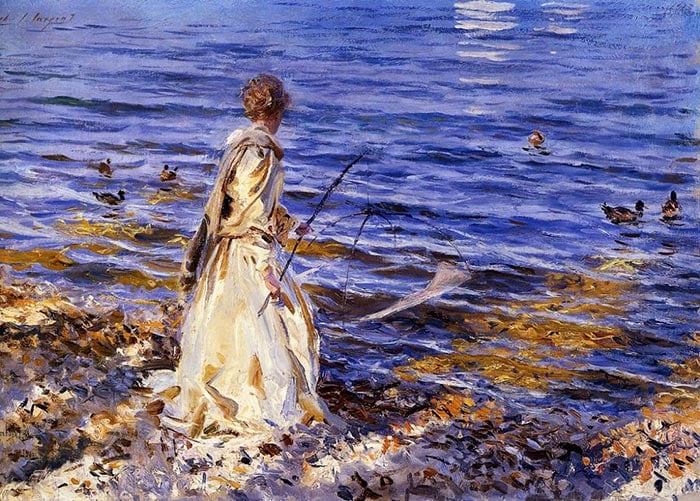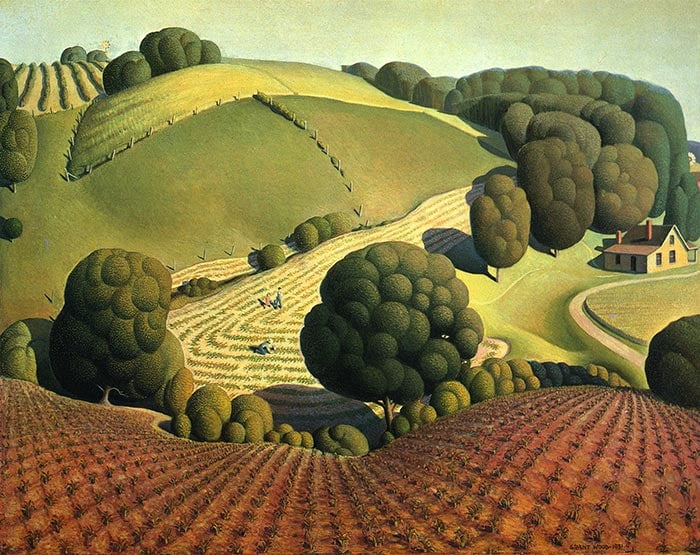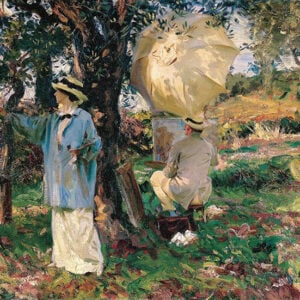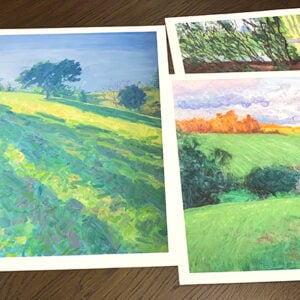Rhythm in art refers to the arrangement of shapes in a way which creates an underlying beat. It is similar to the rhythm of music, but instead of notes and sounds, we use colors and shapes. In this post, I cover:
- Examples of Rhythm in Art
- Tips for Using Rhythm in Art
- Exercise for Your Next Painting
- Want to Learn More?
- Thanks for Reading!
The best way to learn about rhythm in art is to see it in action. Below, I take a closer look at master paintings that feature a strong use of rhythm.

Examples of Rhythm in Art
Below is a fantastic demonstration of rhythm using nature by Claude Monet. The trees are spaced at almost even distances apart, but there is some variance to make it seem natural. This provides a strong beat to the painting.
The leaves on the treetops merge together to create a snaking S-shape. This joins the tree trunks together and reinforces the beat.
In the background, there is a much more organic arrangement of clouds in the sky. This breaks up the sense of rhythm in the painting.

Below is a similar but more realistic example of rhythm by Ivan Shishkin. The tall trees provide a beat to the painting. The beat is stronger with the nearest trees and gets weaker as the trees recede into the masses.
Also, notice how the bottom of the painting is organic and does not appear to have any sense of rhythm. This area contrasts against the strong rhythm of the area above.

In Vincent van Gogh’s Undergrowth with Two Figures, the trees provide a very repetitive beat, which contrasts against the energetic brushwork used for the grass and flowers.

In the painting below by George Inness, rhythm is created by the vague fence posts which recede into the distance. These fence posts then join with the line of trees and houses. This contains your attention around these areas. Also, the tall tree on the right stands out as it does not conform to the standard rhythm of the overall painting. It is like a loud musical note used to grab your attention.

There are two major elements of rhythm in the painting below: the S-shapes created by the ocean breaking along the shore, and the line of boats and people on the shore and in the water.
The foundation of the painting is built on soft, pastel colors. This allows the delicate rhythm of the painting to stand out.

In John Singer Sargent’s painting below, a strong, organic rhythm is created by the contours in the water. The rhythm is stronger and more defined closer to shore.
This rhythm is broken by the fisherwoman. That is what painting is all about: creating a rhythm using patterns and shapes and breaking that rhythm with powerful statements.
The ducks are also arranged in a way that provides a less-regular beat over the top.

In Sargent’s painting below, you can almost feel the rhythm of the orchestra. If you look closely, the drummer and bass players are dominant in the foreground, whilst the brass instruments appear delicate. This mimics their roles in music.

Tips for Using Rhythm in Art
- When it comes to rhythm in art, sometimes less is more. Don’t try to force it if it is not there. But of course, if rhythm is a strong feature of your painting, then you may want to exaggerate it.
- You can make a powerful statement by building up a sense of rhythm in your painting, then abruptly breaking it (like Sargent did to some extent in his Fisherwoman).
- The rhythm of your painting could have many levels, not just one standard beat. Just like there are many different levels of the rhythm to a complex song. It is not just one, regular beat; there are all kinds of tones and sounds woven together. For example, in your painting you could combine a strong beat using dominant and regular shapes, with a subtle beat using intricate details and patterns.
- If you want to make a subtle rhythm stand out in your painting, then you need to tone down the surroundings. Just like in Sorolla’s The Beach in Valencia.

Exercise for Your Next Painting
When you are creating your next painting, think about if the subject has a rhythm that you could capture. If not, consider manipulating the subject or framing it in a way to create a rhythm. For example, you could slightly change the position of certain objects to make them appear more regular, or push some things back and bring other things forward, or change the perspective. Just be careful not to depart too far from the subject you are painting, unless that is part of your strategy.
Also, before I wrap this up, I should note that rhythm does not need to be apparent in your paintings. It is just one of the many tools at your disposal.
Want to Learn More?
You might be interested in my Painting Academy course. I’ll walk you through the time-tested fundamentals of painting. It’s perfect for absolute beginner to intermediate painters.
Thanks for Reading!
I appreciate you taking the time to read this post and I hope you found it helpful. Feel free to share it with friends.
Happy painting!
Dan Scott

Draw Paint Academy







Dan, I did not know about rhythm in paintings and that it is broke. Great learning I am gaining from your blogs. Thank you sincerely.
Thanks for this, Dan. A great inspiration, as I have just been planning a painting of orchard trees near where I live, and was trying to work out the structure of the composition. Rhythm totally makes sense as an approach. As always a helpful and interesting post.
These posts are great. Ones hears in class or reads them here and there but it mau not be clearly explained in a way totally understandable.
I’ve read about creating a body of work to approach galleries, but would love to hear your take on that subject.
I did not know about rhythm in painting but when looking back at my recent attempts in acrylic , I think it was there. Now I understand the concept and will be aware of its use.
Dan, your lessons are invaluable to someone like me who has no formal education in art but loves it & attempts to create it. Thank you, thank you!
Dan, your talent lies way more in art analysis than in painting. Your observations of the so-called elements in art is far more clear and uses much better examples, and understandable language than ANY art history book l’ve read or my 6 courses in art history at the university. You need to collate these and sell a text book. NOT for the $. l think you make more online. But for the sake of art students who never know about your excellent but obscure online courses.
Hi Thomas. Really appreciate your extremely kind words. Means a lot and it is what I strive to provide. Surprisingly, I did not enjoy art history at all during my schooling years. You are right about the book. Maybe one day when I have a bit more time on my plate!
Thanks Thomas! Dan
This was a very helpful tutorial for me. Thinking about the “rhythm” of a painting put me in a new and exciting mental state before starting. Thank you.
This was extremely helpful. I enjoyed scrolling up and down back and forth studying the paintings vs your captions. I learned so much. Wish you would come to Michigan for a seminar I’d be first in line. Susan Jones Farmington Hills Mi
I think a lot of people “feel” the rhythm and paint it subconciously. It is wonderful to be fully aware of what you are seeing and trying to replicate. It makes life more enjoyable when we see rhythem in the clouds, trees, water, mountains and valleys. Hopefully, we don’t get so bound up with trying to have rhythm we lose the joy of creating it. I enjoy your “class.”
Hi Dan
First thanks for your incredible generosity and willingness to share what you know. What you offer, in most cases, would wreck most pockets. You are doing it for free. I always wanted to paint and for the past two years, I am painting almost every day. As you have mentioned, I wish I had come across your website a bit sooner. I can see my own mistakes in my previous paintings (?) if they can be called so. But thanks a million for your insightful writings. I have learned a lot in a short span of time what on my own I would learn in quite a considerable span of time. I am sure about it. Very grateful to you !!
At first, I was skeptical about this rhythm thing you were talking about. But the Singer’s paintings you have put in your blog made me realise that they were deliberately painted that way, especially Orchestra Rehearsal of Jules Etienne Bastard. Would you say Degas’ Ballet paintings were based on this theme?
Thanks a lot!
Thank you for your postings. I especially appreciate the examples of great pieces of art you discuss in reference to your teaching points. I am learning a great deal and am becoming more aware of design principles in art across the spectrum.
Thanks for this, Dan. A great inspiration, as I have just been planning a painting of orchard trees near where I live, and was trying to work out the structure of the composition. Rhythm totally makes sense as an approach. As always a helpful and interesting post.
Thanks for a new way to compose my paintings!
What an amazing tutor you are! Thanks for the valuable lesson.
Thank you yet again for a great read. I am taking notes also as my memory lets me down unless I write these tips etc down.
Thank you for this information. I recently attended a seminar with Scott Christensen and he talked about rhythm but your examples and how you explain it was very helpful .
good
Have ever tried to paint your interpretation of a classical music piece? Can’t find an approach anywhere. I’ll be hopefully watching your utubes